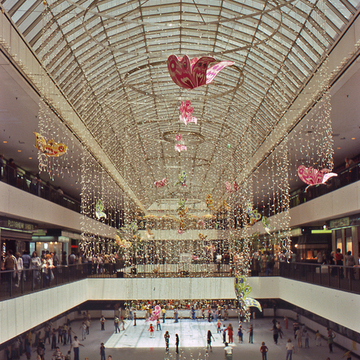The urban anchor of the Post Oak district is the Galleria, the mixed-use shopping, office, and hotel center that Gerald D. Hines Interests opened in 1970, and which has continued to be expanded in phases through the early twenty-first century. It is because of the Galleria that Post Oak Boulevard replaced Main Street as the main shopping street of Houston in the 1970s. Beyond its local impact, the Galleria, like the Astrodome ( HN7), is significant because it became a late-twentieth-century prototype. It is a regional shopping mall that so concentrated segments of the retail market that it could attract and support additional uses (such as hotels and office buildings) to become the kind of urban magnet that American downtowns had been from the 1870s to the 1970s. Contained in a single, privately owned property, the Galleria could be managed to ensure maximum experiential consistency and the financial profitability that accrues from it. As the second (and in some categories, such as retail trade, the primary) downtown of Houston, the Post Oak district was developed in the Galleria's image as an urban center that efficiently eliminated public space, public institutions, and their mixed constituencies to concentrate on consumerism.
The three-level, six-hundred-foot-long mall of 1970; the twenty-one-story Post Oak Tower of 1971; the twenty-story, four-hundred-room Houston Oaks Hotel of 1971 (now the Westin Oaks); and parking garages and decks for 7,040 cars were designed as structurally separate units whose first and second floors are aligned to facilitate pedestrian circulation. HOK made restraint the keynote of the Galleria's design. Rather than extraneous decor, HOK minimized material and color choices, emphasizing precast-concrete panels of rose-colored concrete. Massimo Vignelli's exterior graphics (effaced after Hines sold the Galleria in 1999), Sasaki Dawson and Demay's landscaping around the base of Neiman-Marcus, and Eleanor LeMaire and Associates' original interiors at Neiman-Marcus sustained this impression.
Additions to the complex have not been as architecturally and experientially coherent; they lack communal spaces as compelling as the ice skating rink to compensate for their evident economies of design and construction. Galleria II of 1977 is by HOK and S. I. Morris Associates. Marshall Field and Company of 1979 (now Saks Fifth Avenue) was designed by Johnson/Burgee and S. I. Morris Associates. Galleria III of 1986 by HOK and Richard Fitzgerald and Associates contained Macy's. Galleria IV of 2003 by Cooper Carry of Atlanta lies across W. Alabama Avenue from the back of the Galleria. This contains Macy's and Nordstrom and was built by the Indianapolis-based Simon Property Group, which bought the Galleria in 2002.





















